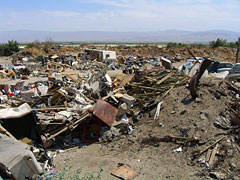Contact EPA Southern California
Pacific Southwest, Region 9
Serving: Arizona, California, Hawaii, Nevada, Pacific Islands, Tribal Nations
Tribes
| Southern California Quick Finder | ||||
|---|---|---|---|---|
| Asbestos Brownfields Children's Health | Disaster Preparedness Grants Indoor Air | Leaking Fuel Tanks Mold | Ports RCRA ID Numbers Vehicle Imports | TMDLs Air Water Infrastructure Wildfires |
EPA’s Pacific Southwest region is home to 146 Indian tribes, many of whom live in areas where meeting basic needs is a challenge. Many tribal households lack access to safe running water, and more than 1,000 open dumps scar tribal lands. EPA has directed funding and other resources to tackle these unacceptable threats to human health and welfare.
Through collaborative efforts across all program offices, EPA works to protect tribal ecosystems, human health, and cultural resources. The map at right shows the location of local tribal lands in southern California.
Tribal success stories on this page:
- Torres Martinez Collaborative Combats Illegal Dumps
- La Jolla Tribe Builds Solid Waste Transfer Station
- Lost Lake Resort: Protecting Drinking Water
Torres Martinez Collaborative Combats Illegal Dumps

Larger image
Illegal dumping on the Torres Martinez Desert Cahuilla Indian Reservation in California’s rapidly growing Coachella Valley reached crisis levels as unscrupulous waste haulers used the open desert land as a dumping ground outside the reach of state regulatory agencies. Illegal dump operators burned massive amounts of waste, creating plumes of smoke that clouded the skies and forced schools to close. New dumpsites appeared overnight on remote reservation roads. Despite persistent efforts, the tribe’s staff were unable to stem the tide of trash.
To combat the dumpers, EPA, the Bureau of Indian Affairs (BIA) and the tribe formed an alliance with 24 federal, state and local agencies and nonprofits in April 2006: The Torres Martinez Solid Waste Collaborative. Members of the collaborative energetically pooled the talents and resources of the various agencies, combining public education, outreach, enforcement and direct action.
In less than two years, the collaborative has achieved impressive results. All illegal dumps on the reservation have been shut down. For the past year, no new dump sites have appeared. The collaborative has cleaned up more than 20 dumps and installed gates, fences and other access controls. Open burning has been almost entirely eliminated. Outreach and public education have redirected haulers to legal disposal and recycling facilities. No single agency could have done it alone. Each success involved the cooperation and participation of multiple agencies.
At the notorious Torlaw illegal dump, where fires created constant smoke, a lawsuit by EPA and BIA ended in victory: The U.S. District Court ordered the operators to shut down and vacate the property. The court also ordered them to pay up to $42.8 million in cleanup costs, plus more than $2.3 million in penalties. After the dump closed, the Riverside County Fire Department and the California Integrated Waste Management Board (CIWMB) chipped and mulched 17,000 cubic yards of green waste to prevent fires.

At the illegal, 25-acre Auclair Dump, EPA removed hazardous waste to a permitted landfill, including 1,400 tons of ash, 400 pounds of asbestos-cement pipes, 1,600 pounds of waste oil and sludge, and 100 cubic yards of discarded wooden grape stakes treated with toxic chromated copper arsenate (CCA). The California Integrated Waste Management Board (CIWMB) finished the cleanup, removing 1,700 tons of debris, 35 tons of metal, and 22 lead-acid batteries.
At another site, just 200 yards from a school in Thermal, the state Department of Toxic Substances Control (DTSC) worked with the tribe and Riverside County Waste Management to remove 100 tons of CCA-treated grape stakes. Elsewhere, EPA took enforcement actions against two mobile home park operators for illegally dumping residents’ trash, securing enforceable commitments to provide trash pickup for the residents and improve waste management.
The California Highway Patrol and the Riverside County Sheriff’s Office have contributed to the effort with aerial monitoring to keep track of the dumpsites and find any new ones. EPA is now working with the tribe and BIA to assess former dumpsites’ potential for reuse.
Additional Resources:
La Jolla Tribe Builds Solid Waste Transfer Station
In rural areas, open dumping of solid waste occurs frequently because small communities and tribes lack funding to set up collection and disposal systems.
In San Diego County California, The La Jolla band of Luiseno Indians took action by building a solid waste transfer station with a grant from the USDA Rural Utilities Service.
By combining the loads of several individual waste collection trucks into a single shipment, communities can save money on the labor and operating costs of transporting the waste to a distant disposal site. Tribal transfer stations are a promising model for sustainable solid waste practices for tribes and other small and rural communities.
Building on this success of the new transfer station, EPA recently awarded funding for the tribe to pilot a recycling program and a household hazardous waste collection and disposal program at their new transfer station. Both grants will allow the tribe to address serious health risks posed by open dumping of wastes.
Lost Lake Resort: Protecting Drinking Water
EPA fined Lost Lake Resort in Desert Center, California, $55,076 for underground storage tank violations that caused groundwater and soil contamination on the Colorado River Indian Tribes reservation.
EPA inspectors, working closely with the Colorado River Indian Tribes (CRIT) Environmental Protection Office, inspected the tanks and discovered faulty piping and a gasoline release into the environment. The tanks are located adjacent to the Colorado River and near two drinking water wells that serve nearby residents.
Lost Lake Resort confirmed the release of a significant amount of gasoline after performing two site assessments required by EPA, and is now developing a cleanup plan to address the contamination. The EPA is working in partnership with the CRIT Environmental Protection Office to ensure that soil and groundwater are properly cleaned up.


